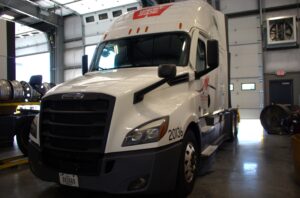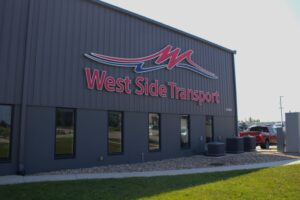
With more than 550 trucks moving cargo across the country at any given moment, there is plenty of information for West Side Transport to analyze when it comes to driver safety, fuel efficiency, and overall sustainability.
Kristopher Gordon, the company’s director of recruitment and sustainability, spoke in-depth about a recent upgrade to the technology on board each truck: new electronic logging devices (ELDs).
ELDs were first mandated for trucking companies as part of the Moving Ahead for Progress in the 21st Century Act, which passed in 2012. ELDs primarily log a driver’s duty status, or the number of hours they are actively driving per day.
Over time, ELDs began to record additional data from drivers on the go, including acceleration, deceleration, average speed, gas mileage, and more.

“So drivers are limited to specific times or amount of times that they’re allowed to drive in a given period. Just for reference, it’s 70 hours a week of total on-duty, it’s 11 hours per day of driving; 14 hours per day of on-duty. So you’re going to have a few hours of them fueling, switching trailers, et cetera,” Mr. Gordon said. “So it logs that, and companies more and more have been integrating the duty status of it with their dispatch system, so sending their load plans through. And then eventually GPS got integrated into it. And so you’ve just seen more and more technology stacks on these devices.”
Upgraded technology
West Side Transport upgraded its ELDs to ISAAC Instrument brand tech this summer. Mr. Gordon said the ISAAC devices, which take the form of removable tablets installed in driver cabins, have transformed the way the company collects and analyzes driver data.
“We can monitor your turning gravimetric force — how fast you’re turning compared to how much you weigh — and are you turning too fast? We can measure your coasting speed. We can measure your idle time,” Mr. Gordon said. “There are probably 50 data points that we can pull in now; dang near everything. If it’s a data point, we can measure it.”
Previously, these data points would be gathered after a drive was complete by hooking a laptop up to a truck’s built-in black box tech. Now the data can be transmitted real-time via satellite back to West Side Transport headquarters — or at any of the company’s terminals across the Midwest.

Besides the ELDs themselves, the world of trucking as a whole has seen many advancements regarding real-time safety and the ability to keep track of all drivers at once.
“We also have your cameras, like your forward-facing cameras that are connected to our satellite. So if an event occurs that gets uploaded via satellite, not just cell signal, within minutes we can see that event,” Mr. Gordon said. “If it’s a hard brake, well, that event gets flagged, uploaded, and within minutes, that gentleman over there in our safety department can view it on his computer.”
He noted that one of the biggest changes the ISAAC system has brought to West Side Transport is the renewed focus on driver behavior. With the new devices, drivers can get real-time feedback on their efficiency and adjust their behavior accordingly. While this can help improve driving times and refueling, Mr. Gordon said, it can also greatly impact the environmental sustainability of operating a truck.
New sustainability
West Side Transport, like most trucking companies, has goals related to sustainability and environmental protection. Specifically, they focus on reducing CO2 emissions through the combustion of diesel fuel.
Mr. Gordon said trying to become more fuel-efficient also serves to save money. He noted that West Side Transport runs a combined 50 million miles a year, so even a 1% improvement in fuel efficiency makes a massive difference.
Achieving this improvement relies more on driver behavior, rather than modifying the trucks themselves.
“You can spec out this truck as much as you want for efficiencies; you can put the little wind guards on them. You can really trick it out. But in the end, you run into science and physics, right?” Mr. Gordon said. “So we are now incentivizing our drivers on four specific categories that the ISAAC device now allows us to display to the drivers, so instant feedback means a behavioral change.”
Mr. Gordon compared this use to the way that many modern cars have an “eco light” that turns on when the driver is making the most of their gas mileage, and not emitting an abundance of emissions.
The main behavioral points Mr. Gordon specified included reducing acceleration pressure, reducing hard braking, and monitoring turning speed based on truck and cargo weight. He said West Side Transport started testing with the ISAAC devices last year and had installed the tech on every truck in the fleet by August 2023.

“Even our testers, our top drivers, the guys that we know on how we previously measured the fuel efficiencies, even they found, ‘Okay, this helped me,’” Mr. Gordon said. “So just in the testing phase, we’ve seen great results.”
He said while ISAAC reports that trucking companies could see up to a 15% increase in fuel efficiency after using their devices, he expects West Side Transport to see at least a 5% difference.
West Side Transport is focusing on sustainability in other ways as well. Mr. Gordon said they recently purchased the first two trucks fueled by compressed natural gas (CNG), also known as propane. While it is still a combustible fuel, propane has significantly less environmental impact than diesel.
According to the U.S. Energy Information Administration, diesel fuel releases 22.45 pounds of CO2 per gallon, while propane releases 12.68 pounds per gallon.
He noted that it is difficult to garner usable economic and emission metrics with only two propane trucks in the fleet. Additionally, because there are no propane fueling stations for trucks in the Corridor — the closest being in Davenport — West Side likely won’t fully branch out into propane for some time.
“That’s one thing we’ve noticed, is that the infrastructure and the technology and really the incentives just are not there. Our partner companies, our customers, of course, want us to be as sustainable as possible, with the least footprint as possible,” Mr. Gordon said.
He noted that while it will take some time for every company in the industry to align their goals for sustainability — and more critically, their funding — it will ultimately take broader-scale interventions for CNG or electric vehicles to become widespread. Still, he noted that efforts like the ISAAC devices are important to get the ball rolling.
“We’re going to have to get more tax incentives. We’re going to have to get an Eisenhower-like sustainability, renewable fuel system, even electric…We would love to electrify our lanes around here. It’s just simply cost prohibitive,” Mr. Gordon said. “We would quite literally go out of business, and any rates we would charge that customer to make up for that would be non-competitive…but we believe the CNG is a good stepping stone.”




